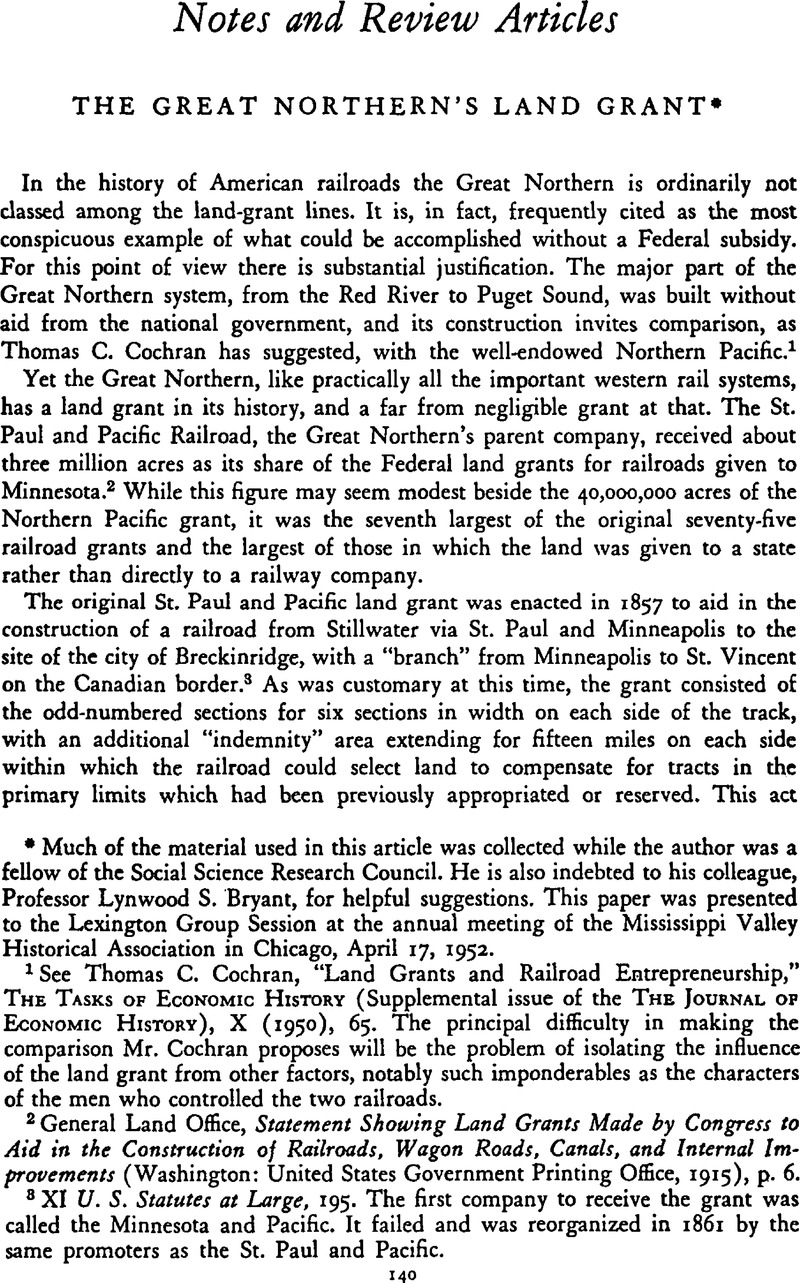Article contents
The Great Northern's Land Grant*
Published online by Cambridge University Press: 03 February 2011
Abstract

- Type
- Notes and Review Articles
- Information
- Copyright
- Copyright © The Economic History Association 1952
References
1 See Cochran, Thomas C., “Land Grants and Railroad Entrepreneurship,” The Tasks of Economic History (Supplemental issue of the The Journal of Economic History), X (1950), 65Google Scholar. The principal difficulty in making the comparison Mr. Cochran proposes will be the problem of isolating the influence of the land grant from other factors, notably such imponderables as the characters of the men who controlled the two railroads.
2 General Land Office, Statement Showing Land Grants Made by Congress to Aid in the Construction of Railroads, Wagon Roads, Canals, and Internal Improvements (Washington: United States Government Printing Office, 1915), p. 6Google Scholar.
3 XI U. S. Statutes at Large, 195. The first company to receive the grant was called the Minnesota and Pacific. It failed and was reorganized in 1861 by the same promoters as the St. Paul and Pacific.
4 J. M. Edmunds, Commissioner of the General Land Office, to E. F. Drake, President, St. Paul and Pacific Railroad, December 11, 1862, in G. L. O. Div. F, Letter Record, LXVII, 358.
5 See the map in Henry, Robert S., “The Railroad Land Grant Legend in American History Texts,” Mississippi Valley Historical Review, XXXII (September 1945), 180Google Scholar.
6 H. R. Exec. Doc. No. 29, 47th Cong., 2d Sess. (June 10, 1880).
7 W. J. Drummond, Commissioner of the General Land Office, to Enoch Trott, Land Commissioner of the St. Paul and Pacific, November 24, 1871, in G. L. O. Div. F, Letter Record, LXX, 450.
8 St. Paul, Minneapolis, and Manitoba v. Phelps, 137 U. S. 528 (1891).
9 XXVII U. S. Statutes at Large (August 5, 1892), 390.
10 Pyle, J. G., Life of James J. Hill (New York, 1917), I, 197Google Scholar.
11 Ibid., p. 252. Actually the danger of forfeiture was not quite this acute. In Schulenburg v. Harriman, 21 Wallace 44 (Oct. 1874), the Supreme Court held that the forfeiture clause did not operate automatically but could be invoked only by specific legislative or judicial action. (For a detailed discussion of this point, see Ellis, David M., “The Forfeiture of Railroad Land Grants, 1867–1914,” Mississippi Valley Historical Review, XXXIII [June 1946], 30–31Google Scholar.) It was, of course, possible that the Northern Pacific might use its political influence to take advantage of a technical default on the part of its rival—which would have been a clear case of the pot calling the kettle black.
12 Pyle, Hill, II, Appendix 3.
13 Larson, Henrietta M., Jay Cooke, Private Banker (Cambridge, Mass., 1936), p. 280CrossRefGoogle Scholar. The two railroads traversed the same territory and were bound to be closely related, either as rivals or partners. During the Cooke regime, the Northern Pacific acquired control of the St. Paul and Pacific until the latter went into receivership in 1873.
14 Ibid., p. 418. There is a problem here of distinguishing between fortune and foresight. Because of his interest in the Red River traffic, Hill had been watching the St. Paul and Pacific for some years before he attempted to get control of it. One of the attributes of a successful entrepreneur is presumably the ability to see an upswing coming.
15 A land grant was always a future asset, whose full value could be realized only after the railroad had been built. Professor Cochran has pointed out that the capital value of such an asset is considerably less than its total net return. Cochran, “Land Grants,” p. 66. The railways that managed their grants most successfully have followed a policy of selling to settlers on easy terms and making their money from the traffic thus created rather than from the sale of the land itself.
16 Due, Thomas Le, “The Disposal of the Public Domain on the Trans-Mississippi Plains: Some Opportunities for Investigation,” Agricultural History, XXIV (October 1950), 199–204Google Scholar; William S. Greever, “A Comparison of Railroad Land-Grant Policies,” Ibid., XXV (April 1951), 83–90.
17 Greever, pp. 84–85.
18 Ibid., p. 85. This estimate is made in Federal Co-ordinator of Transportation, Public Aids to Transportation (Washington, D. C, 1938–40), I, 43Google Scholar.
- 2
- Cited by




